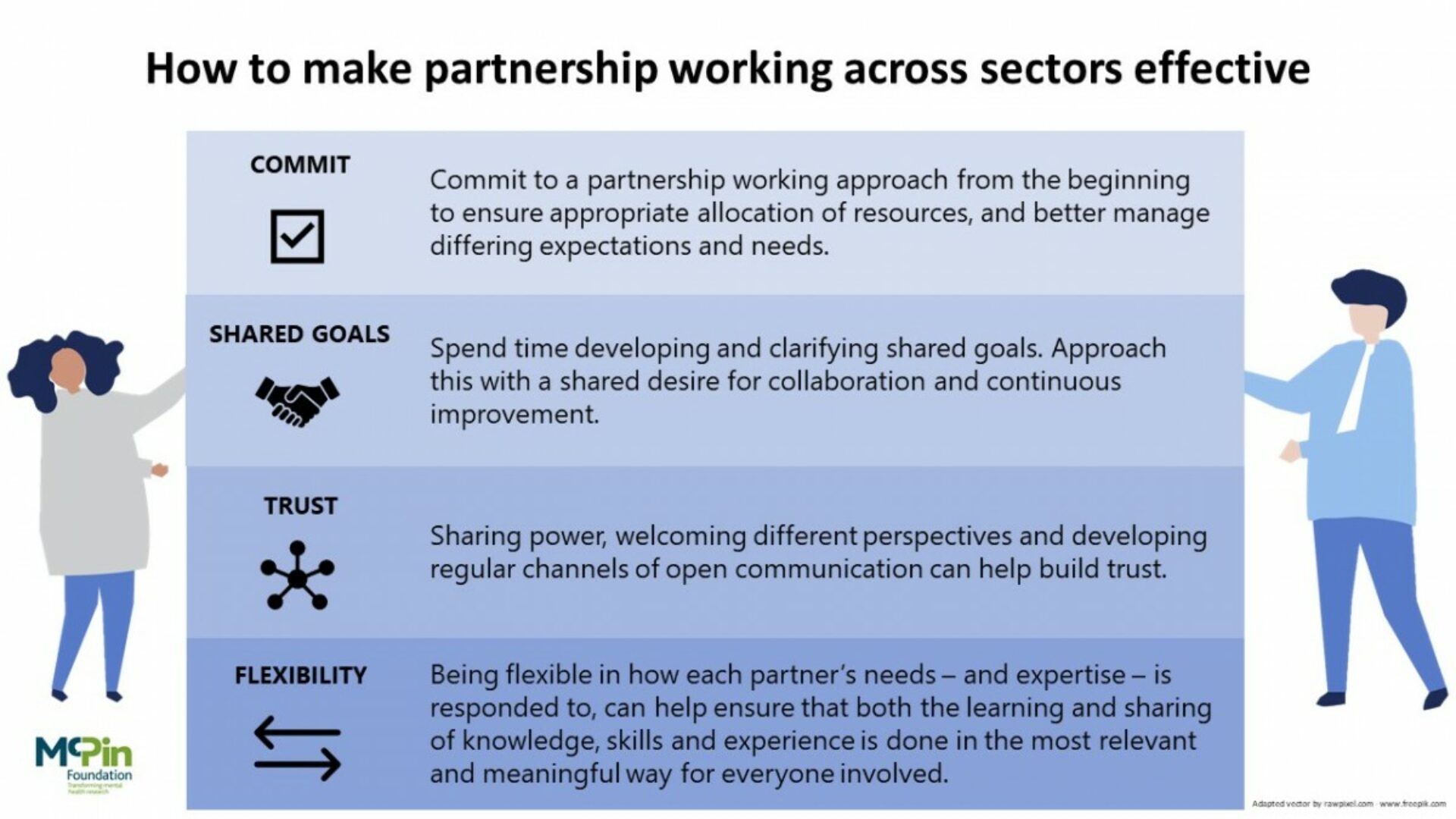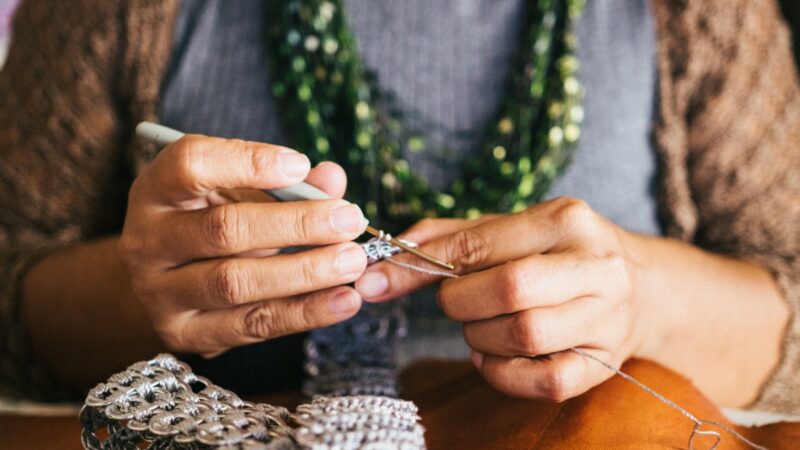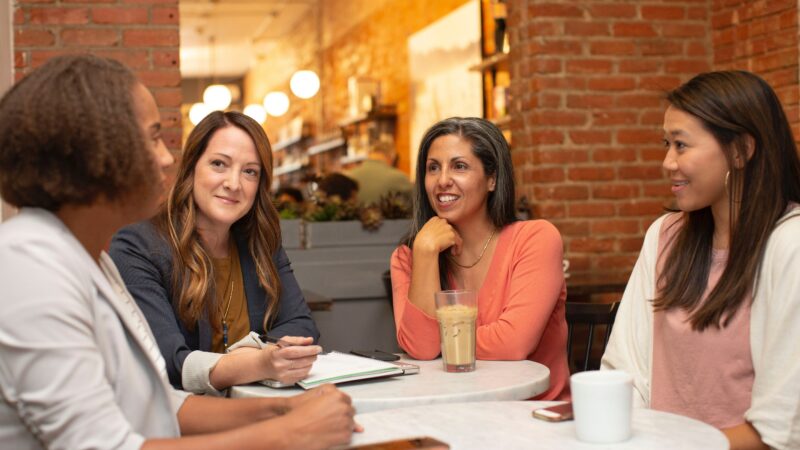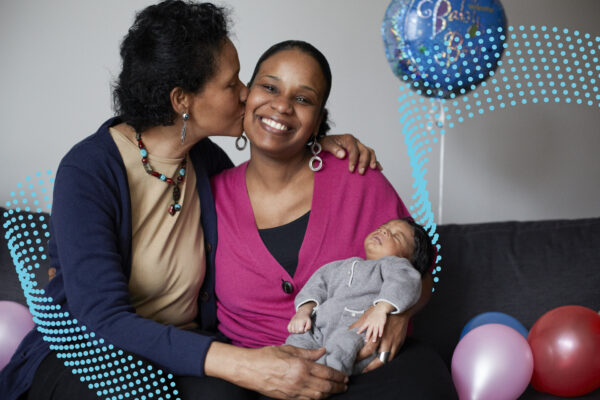Image adapted from people vector created by rawpixel.com – www.freepik.com
A senior peer researcher shares what they learnt about how to work in partnership from our evaluation work on Women Side by Side.
Humma Andleeb
Partnership working occurs when stakeholders that are working towards a common goal, as partners, come together to learn and share their expertise with each other.
It can be a powerful approach to deliver shared aims, where specialist expertise is required, and where barriers to knowledge mobilisation, such as a lack of funds and resources, exist.
Working in partnership also strengthens the capacity of programmes to engage a broad range of stakeholders, and thus achieve more meaningful and relevant objectives.
We learnt a lot about how to work in partnership from our evaluation work on Women Side by Side. This was a women-led peer support programme for women who are at risk of, or who experience ‘multiple disadvantage’1.
At a programme level, it involved Mind, the mental health charity, partnering with Agenda, the alliance for women and girls at risk. The shared goal was ultimately to learn how to deliver effective gender-responsive trauma-informed peer support for women – a vital and urgent need that has emerged over recent years.
Partnership working in Women Side by Side enabled organisations situated within the women’s sector to develop their mental health support, and strengthen peer support.
This represents expertise that has long been developed in community peer support evaluations. Learning and sharing knowledge in this way enabled these principles to be scrutinised under a gendered lens and to understand how well they apply to women who have experienced ‘multiple disadvantage’.
In the same vein, mental health organisations were able to deepen their understanding of women’s needs, and learn how to better deliver women-centred trauma-informed peer support to women with experience of ‘multiple disadvantage’.
As well as this, they were able to learn how mental health support can be better tailored to the needs of women – who are more likely to experience specific traumas, such as domestic or sexual abuse.
Bringing people, projects, organisations, and other regional networks together in this way made learning effective, because not only was there a readily available and varied pool of expertise, but learning was directly informed by need.
Making learning effective
A regional hub model was used to facilitate partnership working in Women Side by Side. This brought programme-funded projects, specialist organisations, and networks within defined regions, together in ‘hubs’ on a regular basis to share and learn (see diagram below).
A variety of topics were covered at these events, including how to deliver peer support, safeguarding and boundaries of peer support, trauma-informed approaches, intersectionality, sustainability, and future funding opportunities.
Local commissioners, peer support workers, people with lived experience expertise, and other relevant local networks, were also invited to engage with the events and share resources in their local areas.
Bringing people, projects, organisations, and other regional networks together in this way made learning effective, because not only was there a readily available and varied pool of expertise, but learning was directly informed by need, under the shared goal to deliver trauma-informed gender-responsive peer support to women.
For example, projects were able to request information and resources on specific topics, and this informed the programme at the hub events. This sharing of knowledge was often provided by other programme-funded projects who had this expertise, or local networks.
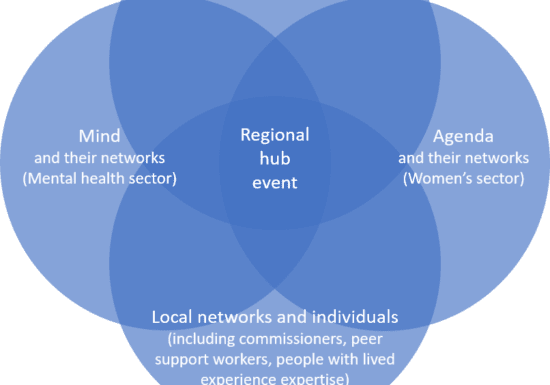
These centralised hub events also facilitated networking that, for many, would not otherwise have been possible. Interestingly, our evaluation of the learning events in Women Side by Side revealed that networking opportunities were a valued aspect of the programme for attendees.
Reflecting on the impact that working in partnership can have, we wanted to understand more about what can help make this a success. So far, we have come up with the following four factors:
- Work together from the outset: Embedding a partnership working approach into a programme of work from the beginning helps ensure that the appropriate amount of time, funds and other resources are allocated to planning and delivering this aim. Doing so can also help better manage differing expectations and accommodate differing needs.
- Shared goals: It is important to spend time developing and clarifying the shared goals of the partnership. Having a clear focus can help unite stakeholders, who naturally will each have a distinct focus. It goes without saying that this needs to be underpinned by a shared desire for collaboration, and for continuous improvement.
- Trust: Partnership working requires trust. Trust is not something that necessarily pre-exists, but can evolve over time. However, a commitment to sharing power, being open to other’s perspectives, and developing regular channels of open communication, can help pave the way for building strong, trusting relationships at multiple levels within a partnership.
- Flexibility: Not sticking to a rigid approach, but being flexible in how an individual partner’s needs – and expertise – is responded to, can help ensure that both the learning and sharing of knowledge, skills and experience is done in the most relevant and meaningful way for everyone involved.
Finding common ground takes time, constant effort, curiosity - and a willingness to be vulnerable, both at an individual and organisational level.
Overcoming challenges
This all sounds great, but challenges do exist in practice.
This is understandable given that partnership working is about bringing together different stakeholders, who each have their own distinct focus. Thus, by definition, they are each likely to have differing perspectives, priorities, expectations, ways of working, and so on.
Finding common ground takes time, constant effort, curiosity – and a willingness to be vulnerable, both at an individual and organisational level. Other challenges exist as well, such as time and money.
Frustratingly, austerity, not to mention the further economic impact of the coronavirus pandemic, make these challenges even more difficult to overcome.
In Women Side by Side, the biggest challenge was the short time frame for delivery, which was only one year. A large focus was sustainability and ensuring projects could continue after this time, through training and future funding. However, this will have been severely affected by the subsequent coronavirus pandemic.
Thus, sowing the seeds of this type of work can require significant commitment and effort, particularly at the beginning. However, despite this, the beauty of working in partnership is that, when given the right amount of time, space and resources to grow, it has the potential to evolve into something that is independent of the structures in which it first started.
We witnessed the beginnings of this in Women Side by Side. Over time, we observed a shift from a programme-led approach to a more project-led, partnership building approach.
What was especially striking was the reciprocity that developed. For example, some of the projects began to freely offer space and resources for others in the programme to use.
In one instance, this not only enabled training to be delivered in a remote area, but it also meant that more people had the opportunity to benefit from the training. The potential of partnership working to become self-sustaining was powerfully summed up by a participant in a mental health organisation involved in Women Side by Side.
They explained that, as a result of learning how to better provide support for women who had experienced domestic abuse, and how to better utilise trauma-informed approaches, they made the decision to change organisational policy to include working with women in leadership positions – and so embody the ethos of partnership working – in any future efforts going forward.
1Women with experience of multiple disadvantage: Refers to women who are experiencing or have experienced combinations of poverty, poor mental health, issues with drugs or alcohol, contact with the criminal justice system and homelessness.
Women facing multiple disadvantage have very complex, overlapping needs and are at the sharpest end of inequality. Their experiences of disadvantage are frequently underpinned by a history of extensive violence and abuse (taken from the McPin Evaluation of Women Side by Side Report).
Humma Andleeb was a Senior Peer Researcher for the evaluation of Women Side by Side at the McPin Foundation.
Our report from Women Side by Side can be found here.
Other blogs in this series:
- Women Side by Side shows what can happen if women are given the space to grow
- Overcoming imposter syndrome as a peer researcher
- Women Side by Side has helped raise awareness of mental health in a BAME community
- Using a peer research approach to evaluate women-led peer support
Edited by Kathryn Watson, Communications Officer at the McPin Foundation.
